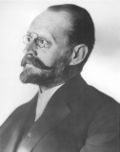Lutetium(III) chloride or lutetium trichloride is the chemical compound composed of lutetium and chlorine with the formula LuCl3. It forms hygroscopic...
8 KB (508 words) - 17:46, 23 September 2024
lutetium(III) chloride containing the radioactive isotope 177Lu, which undergoes beta decay with a half-life of 6.64 days. Lutetium (177Lu) chloride is...
12 KB (797 words) - 04:38, 21 September 2024
Lutetium(III) oxide, a white solid, is a cubic compound of lutetium sometimes used in the preparation of specialty glasses. It is also called lutecia...
5 KB (361 words) - 13:42, 15 July 2023
reacting lutetium oxide with hydrogen fluoride, or reacting lutetium chloride and hydrofluoric acid. It can also be produced by reacting lutetium sulfide...
16 KB (1,801 words) - 11:58, 24 May 2024
Lutetium(III) fluoride is an inorganic compound with a chemical formula LuF3. Lutetium(III) fluoride can be produced by reacting lutetium oxide with hydrogen...
4 KB (319 words) - 17:57, 18 August 2022
Yttrium(III) chloride is an inorganic compound of yttrium and chloride. It exists in two forms, the hydrate (YCl3(H2O)6) and an anhydrous form (YCl3)....
7 KB (406 words) - 15:23, 12 July 2024
Ytterbium(III) chloride (YbCl3) is an inorganic chemical compound. It reacts with NiCl2 to form a very effective catalyst for the reductive dehalogenation...
12 KB (971 words) - 18:07, 7 April 2024
Scandium(III) chloride is the inorganic compound with the formula ScCl3. It is a white, high-melting ionic compound, which is deliquescent and highly...
8 KB (542 words) - 12:58, 4 July 2023
Lutetium(III) hydroxide is an inorganic compound with the chemical formula Lu(OH)3. Reacting lutetium chloride and alkalis will first produce Lu(OH)2Cl...
2 KB (157 words) - 13:36, 31 December 2022
Group 3 element (redirect from Group III elements)
rare-earth elements. It contains the four elements scandium (Sc), yttrium (Y), lutetium (Lu), and lawrencium (Lr). The group is also called the scandium group...
53 KB (5,863 words) - 07:42, 22 October 2024
Lawrencium (redirect from Eka-lutetium)
Chemistry experiments confirm that lawrencium behaves as a heavier homolog to lutetium in the periodic table, and is a trivalent element. It thus could also be...
41 KB (8,137 words) - 23:40, 13 October 2024
Chromium (redirect from Chromium(III))
oxidize to chromium(III) derivatives in air. Water-stable chromium(II) chloride CrCl 2 that can be made by reducing chromium(III) chloride with zinc. The resulting...
110 KB (11,965 words) - 20:43, 19 October 2024
Praseodymium acetylacetonate (redirect from Praseodymium(III) acetylacetonate)
(1992). "Synthesis of yttrium, lanthanum, neodymium, praseodymium and lutetium alkoxides and acetylacetonates". Izvestiya Akademi Nauk, Seriya Khimicheskaya...
5 KB (401 words) - 23:23, 4 February 2024
Ytterbium (section Yb(II) vs. Yb(III))
"lutecia" was separated from ytterbia, from which the element "lutecium" (now lutetium) was extracted by Georges Urbain, Carl Auer von Welsbach, and Charles James...
41 KB (5,222 words) - 10:29, 13 August 2024
significant historical interests. Actinium(III) chloride – AcCl3 Actinium(III) fluoride – AcF3 Actinium(III) oxide – Ac2O3 Aluminium antimonide – AlSb...
119 KB (8,735 words) - 18:51, 11 November 2024
Lanthanide trifluoromethanesulfonates (redirect from Lutetium(III) triflate)
acid catalysts. These catalysts function similarly to aluminium chloride or ferric chloride, but they are water-tolerant (stable in water). Commonly written...
8 KB (924 words) - 12:07, 2 November 2024
Carl Auer von Welsbach (section Lutetium and ytterbium)
was also one of three scientists to independently discover the element lutetium (which he named cassiopeium), separating it from ytterbium in 1907, setting...
28 KB (2,640 words) - 18:54, 25 October 2024
elements (lutetium through mercury) follows, and finally six main-group elements (thallium through radon) complete the period. From lutetium onwards the...
250 KB (26,986 words) - 04:50, 11 November 2024
the "interpenetrating primitive cubic" structure, also called a "caesium chloride" or B2 structure. This structure is often confused for a body-centered...
49 KB (3,620 words) - 14:56, 4 October 2024
Isotopes of hafnium and lutetium (along with ytterbium) are also used in isotope geochemistry and geochronological applications, in lutetium-hafnium dating. It...
46 KB (5,411 words) - 23:56, 8 November 2024
citations] In Australia, most centres synthesise the lutetium-177 peptide on-site from lutetium-177 chloride and the appropriate peptide. Like any form of radiotherapy...
28 KB (2,914 words) - 02:17, 16 July 2024
LuB4 lutetium boride 12688–52–7 LuBr3 lutetium bromide 14456–53–2 LuCl3 lutetium chloride 10099–66–8 LuF3 lutetium fluoride 13760–81–1 LuI3 lutetium iodide...
139 KB (120 words) - 17:07, 15 July 2024
Protactinium (redirect from Protactinium chloride)
protactinium(IV) fluoride and dodecahedral in the chloride and bromide. Brown-colored protactinium(III) iodide has been reported, where protactinium ions...
50 KB (5,847 words) - 01:40, 14 November 2024
lanthanide series, a group of 15 similar elements between lanthanum and lutetium in the periodic table, of which lanthanum is the first and the prototype...
48 KB (6,048 words) - 10:26, 10 September 2024
structure between the halogens. So, chloride (AmCl3) is reddish and has a structure isotypic to uranium(III) chloride (space group P63/m) and the melting...
77 KB (9,332 words) - 09:20, 16 November 2024
tetrakis(methylammonium) hexachloroferrate(III) chloride (I) and tetrakis(hexamethylenediammonium) hexachloroferrate(III) tetrachloroferrate(III) tetrachloride (II)". Inorganica...
150 KB (17,078 words) - 12:22, 24 August 2024
Copper (redirect from Copper(III))
methods are used including leaching with sulfuric acid, ammonia, ferric chloride. Biological methods are also used. A significant source of copper is from...
122 KB (13,921 words) - 21:34, 13 November 2024
3CO Ytterbium(III) oxide is a white powder. It reacts with carbon tetrachloride or hot hydrochloric acid to form ytterbium(III) chloride: 2 Yb2O3 + 3 CCl4...
6 KB (451 words) - 21:11, 18 August 2024
Thallium (section Thallium(III))
Thallium(III) sesquichalcogenides do not exist. The thallium(I) halides are stable. In keeping with the large size of the Tl+ cation, the chloride and bromide...
52 KB (5,787 words) - 10:39, 15 November 2024
iron(III) fluoride even in cold temperatures. When chlorine comes into contact with a heated iron, they react to form the black iron(III) chloride. However...
52 KB (5,499 words) - 01:48, 9 November 2024























